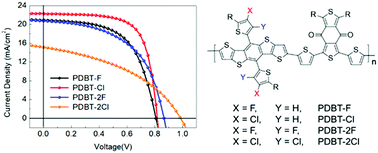Significant influence of halogenation on the energy levels and molecular configurations of polymers in DTBDT-based polymer solar cells†
Abstract
Significant improvement in the power conversion efficiencies (PCEs) of polymer solar cells (PSCs) has been achieved due to the continuous development of highly efficient photoactive materials with tuned energy levels and molecular configurations. Herein, the effects of halogenation on polymers as well as the corresponding photovoltaic performances were systematically studied. Moreover, four fluorinated or chlorinated polymers, i.e., PDBT-X (X = F, Cl, 2F, and 2Cl), based on dithieno[2,3-d:2′,30-d′]-benzo[1,2-b:4,5-b′] dithiophene (DTBDT) were synthesized. Different kinds and extents of halogenations have different impacts on the energy levels and molecular configurations of the polymers; when the polymers are blended with the non-fullerene acceptor IT-4F, the devices based on PDBT-Cl:IT-4F exhibit the highest PCE of 12.6%, which is the best performance reported to date for devices based on the DTBDT polymer. The devices based on PDBT-F, -2F, and -2Cl showed the PCE of 10.0%, 10.2% and 6.2%, respectively. The low PCEs were attributed to the poor stacking and random orientation of the polymer:IT-4F blending films.



 Please wait while we load your content...
Please wait while we load your content...